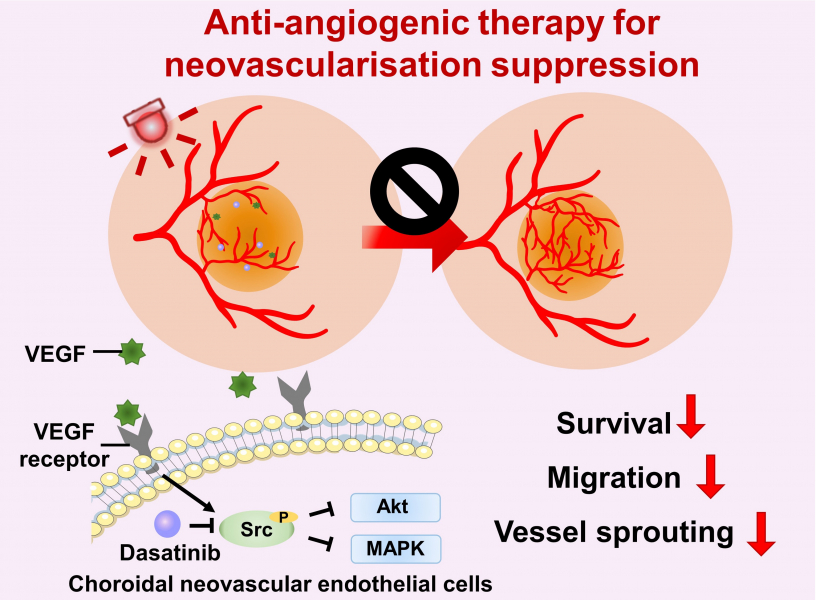| Nov 27, 2023 |
|
(Nanowerk News) Researchers at the LKS Faculty of Medicine of the University of Hong Kong (HKUMed), and collaborators from the Zhongshan Ophthalmic Centre of Sun Yat-sen University, Guangzhou, have developed a light-activatable prodrug nanomedicine for age-related macular degeneration (AMD) therapy. Through the intravenous injection of the nanomedicine and application of light irradiation to diseased eyes, anti-angiogenic and photodynamic combination therapy can be activated, offering a minimally invasive alternative for the treatment of AMD and other ocular disorders characterised by abnormal blood vessel growth.
|
Key Takeaways
|
|
New nanomedicine for age-related macular degeneration offers a minimally invasive treatment alternative, combining anti-angiogenic and photodynamic therapies.
Intravenous injection and targeted light irradiation activate the nanomedicine, addressing the limitations of current intravitreal injection treatments.
The innovative approach demonstrates significant efficacy in regressing abnormal blood vessel growth without noticeable side effects in a mouse model.
This research marks the first integration of a photoactivatable anti-angiogenic agent with a photosensitiser in a single nanoformulation for ocular disorder treatment.
The study’s promising results with FDA-approved components suggest potential for future clinical applications in treating AMD and other neovascular ocular disorders.
|
 |
| Photodynamic therapy (PDT) offers a clinical solution by utilising non-toxic photosensitisers activated by specific wavelengths of light to generate reactive oxygen species (ROS), which can damage and obliterate neovascularisation. (Image: HKU)
|
The Research
|
|
The research has been published in Advanced Science (“Red Light-Triggered Anti-Angiogenic and Photodynamic Combination Therapy of Age-Related Macular Degeneration”), and a Patent Cooperation Treaty application was filed based on the research.
|
Background
|
|
According to the Hong Kong Eye Survey data published in 2019, the prevalence of early AMD among individuals aged 70 and older has reached 7.5% in Hong Kong1, making AMD the second most common cause of visual impairment and blindness in the adult population of Hong Kong. Currently, intravitreal injections of antibodies against vascular endothelial growth factor are the first-line treatment for wet AMD.
|
|
However, this invasive procedure is uncomfortable for patients, and carries the risk of serious ocular complications, such as endophthalmitis and retinal detachment. Therefore, there is an urgent need for novel formulations that enable the delivery of anti-angiogenic agents into the eye without an intravitreal injection, such as intravenous injection.
|
|
Additionally, anti-angiogenic agents have limited efficacy in regressing existing neovascularisation. Photodynamic therapy (PDT) offers a clinical solution by utilising non-toxic photosensitisers activated by specific wavelengths of light to generate reactive oxygen species (ROS), which can damage and obliterate neovascularisation. PDT is widely used for the treatment of polypoidal choroidal vasculopathy, a common subtype of wet AMD in Asia. Therefore, combining anti-angiogenesis therapy with PDT may offer a more effective approach to treating wet AMD, thus helping slow down the progression of the disease and improve the vision outcome for patients.
|
Research methods and findings
|
|
The research team designed a novel photoactivatable prodrug nanosystem. After a single intravenous injection of the nanoparticles into a choroidal neovascularisation mouse model, red-light irradiation of the mouse’s eye activated the nanoparticles to generate ROS, which not only causes the regression of abnormal neovascularisation, but also triggers the release of anti-angiogenic drugs from the nanoparticles to inhibit the growth of new blood vessels. This combinational therapy demonstrated excellent therapeutic efficacy without any noticeable systemic or ocular side effects.
|
 |
| Anti-angiogenic therapy suppresses choroidal neovascularisation (CNV) by inhibiting vascular endothelial growth factor (VEGF)-related pathways. The study represents the first attempt at integrating a photoactivatable anti-angiogenic agent with a photosensitiser into a single nanoformulation for age-related macular degeneration treatment, which opens up new avenues for the development of minimally-invasive therapeutics for AMD and other neovascular ocular disorders.(Image: HKU)
|
Research significance
|
|
The study represents the first attempt at integrating a photoactivatable anti-angiogenic agent with a photosensitiser into a single nanoformulation for AMD treatment. The treatment procedure is simple and safe, as the therapeutic effect of the anti-angiogenic agent and photosensitiser in ocular lesions can be achieved through the intravenous administration of nanoparticles and light irradiation to the eye.
|
|
This pioneering research may open up new avenues for the development of minimally-invasive therapeutics for AMD and other neovascular ocular disorders. The formulation uses US FDA-approved therapeutic agents and excipients, making it promising for future clinical translation.
|
- SEO Powered Content & PR Distribution. Get Amplified Today.
- PlatoData.Network Vertical Generative Ai. Empower Yourself. Access Here.
- PlatoAiStream. Web3 Intelligence. Knowledge Amplified. Access Here.
- PlatoESG. Carbon, CleanTech, Energy, Environment, Solar, Waste Management. Access Here.
- PlatoHealth. Biotech and Clinical Trials Intelligence. Access Here.
- Source: https://www.nanowerk.com/nanotechnology-news2/newsid=64124.php





